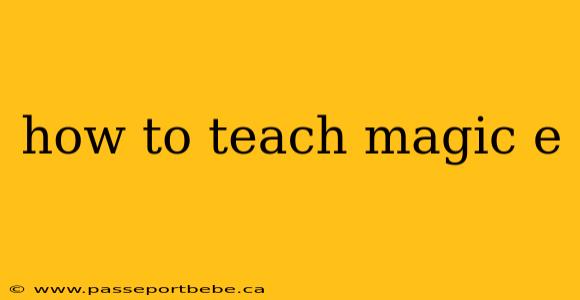Teaching the concept of "Magic E" (also known as the silent E) can be a fun and engaging process for both educators and students. Magic E transforms the pronunciation of vowels in words, changing them from short sounds to long sounds. Here’s a comprehensive guide on how to effectively teach Magic E.
Understanding Magic E
What is Magic E?
Magic E refers to the silent 'e' at the end of a word that changes the vowel sound in the preceding syllable from a short sound to a long sound. For example:
- cap becomes cape
- kit becomes kite
- hop becomes hope
The Rule
The general rule is that when 'e' appears at the end of a word, it is not pronounced, but it changes the vowel sound in the word. This can be summarized as:
- CVC (Consonant-Vowel-Consonant) + E = long vowel sound
Steps to Teach Magic E
1. Introduction to the Concept
Start by explaining the concept of Magic E to your students. Use simple language and give clear examples. You can say:
- "Today, we are going to learn about a special letter called Magic E. It helps other vowels say their names!"
2. Use Visual Aids
Visual aids can be very helpful in teaching this concept. Use:
- Flashcards: Create flashcards with CVC words on one side and their Magic E counterparts on the other side.
- Charts: Display a chart that lists short vowel sounds alongside their long vowel counterparts.
3. Engage with Activities
Make learning interactive. Some effective activities include:
Word Sorting
- Create two columns on a board: one for CVC words and another for Magic E words.
- Have students sort words into the correct columns, reinforcing their understanding of the concept.
Magic E Songs
- Incorporate songs or chants that include Magic E examples. This makes learning enjoyable and memorable.
4. Practice with Examples
Provide students with a variety of examples, including:
- Single-Syllable Words: Cat - Kate, Bed - Bede
- Multi-Syllable Words: Hoping, Making
5. Reading and Writing Activities
Reading Practice
Choose books or passages that feature multiple Magic E words. Ask students to identify and underline them as they read.
Writing Sentences
Have students create sentences using Magic E words. This will help reinforce their learning through writing.
6. Reinforce with Games
Make learning fun with games that focus on Magic E. Consider:
- Memory Games: Match CVC words with their Magic E counterparts.
- Bingo: Create bingo cards with Magic E words for an interactive review session.
7. Assess Understanding
Finally, assess your students’ understanding through informal assessments such as quizzes or group discussions. Ask them to explain the concept in their own words or create their own Magic E words.
Conclusion
Teaching Magic E is an important part of helping students understand phonics and improve their reading skills. By using engaging methods such as visuals, activities, and games, students will enjoy learning and be able to grasp the concept effectively. Remember, patience and practice are key to mastering Magic E!
